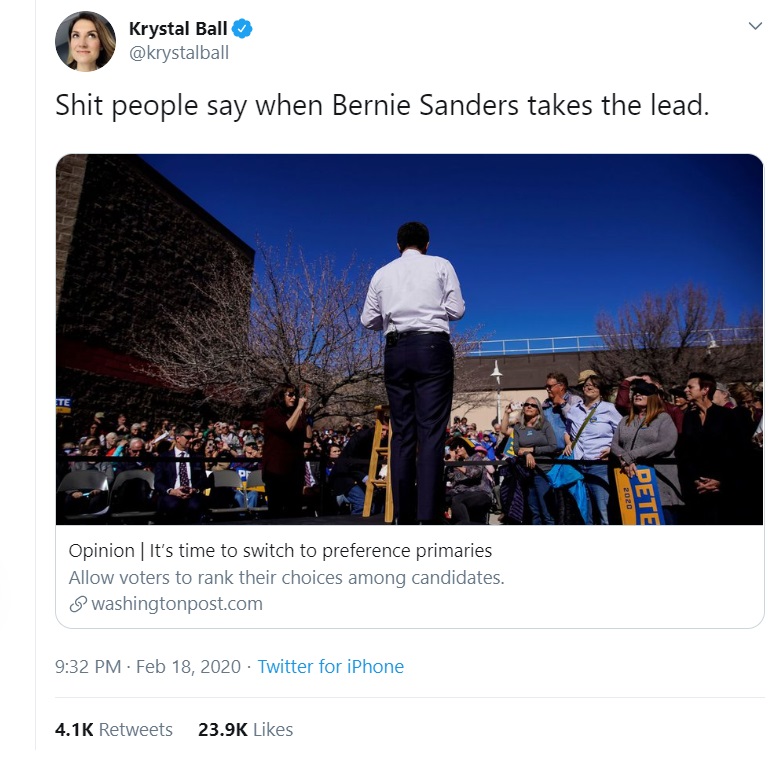By Jesse Sumpter
On Tuesday, the Washington Post released an opinion piece titled, “It’s time to give the elites a bigger say in choosing the president.” There was an uproar on Twitter and the Post changed the title to “It’s time to switch to preference primaries.” The piece makes the case for preference voting at primaries which might be a decent idea but the original title blew that idea to shreds. The title clearly states that elites need to have more power in choosing the president and the way to have that is through preference voting in primaries.
This article pulled back the curtain and revealed the real factions at work in America. The two party system with the Democrats and the Republicans often obscures the more important factions in our country: the Elites and the People.
While America is a country with a lot of social and economic mobility, it also has an elite group. This group would be those who have a lot of economic wealth and lead key social and cultural institutions. This would include big tech owners, Hollywood actors and producers, politicians, university presidents and professors, and news media figures. This would be the Elites.
The second group is those who are not the Elites. This is the group of people who are not in powerful cultural positions. Sometimes they are poor. They are often blue collar workers. They do not own big corporations. They do not have lots of money. This would include farmers, construction workers, waiters, cashiers, janitors, and others. This would be the People.
These two groups are important to understand because these two groups do not align perfectly with the two party system. You can find both groups in both parties and the numbers in each group are frequently changing.
These two groups are largely at odds with each other. The Elites are seeking power and influence; the People are seeking freedom and independence. This sets the two factions against each other.
In America, there are two paths to gaining political power: support from the Elites or support from the People. The power of these factions is mitigated by the branches of government and state system in America.
These two factions explain much about Trump being president and the recent Opinion piece in the Washington Post.
The Elites
While some might assume that the Elites are automatically bad because they have more power, I would argue that this group does not have to be bad. Many elites use their influence and power for good in our country. But we also know that many do not. And while this group does have a lot of influence in the country, it is not the only factor in politics and culture.
The Elites do have a lot of cultural power, but their power is limited because they are fewer in number than the People. This is both a positive and negative factor for this group.
The size of the Elite group is a negative factor because they do not have as much power in elections. This is why the Washington Post article suggested an alternative voting system in the primaries. The Elites are able to increase their limited influence by advertising, campaigning, and promoting certain people and information, like the Post article. This helps but it is not the only factor in political power.
The size of the Elite group is a positive factor for them because the Elites are more easily unified. It is easier to unify a smaller group of interests rather than a larger group of interests. The Elites often share similar goals and so they can find this unity more easily. This unity makes them a powerful force to deal with. This is also the reason that many politicians bend to the interests of the Elites. They are easier to appease.
When the Elites are promoting a leader to a political office they are doing so because they will be able to get from him what they want. If a political figure arises who is against the Elites, this frustrates this group and foils their goals.
The People
While the People are not as powerful as the Elites in terms of cultural institutions, collectively the People have a majority. They are larger in number than the Elites. This is both a positive and a negative factor for this group.
The size of this group is a negative factor because it is harder to unify so many people. There are various interests at work in this group which divides them into smaller factions. This in turn means it has less power.
The size of this group is a positive factor because when they are unified they are able to push back on the institutional power of the Elites. This means that the People in voting have the ability to remove a person from office or to promote one for office. While it is easier for a politician to appease the Nobles because they are fewer; it is harder to appease the People because they are many.
This is the strength of the People. When the People become frustrated with what the Elites are doing, they find a person they can support who will protect them from the Elites.
Enter Trump
Understanding these two factions is key to understanding Trump. Both factions–the Elites and the People–are looking for a leader who will protect and promote their interests. Trump has aligned himself with the interests of the People.
This appeal to the People can be clearly seen in his rhetoric. He talks about draining the swamp. He is talking about the Elites in Washington who need to be confronted. This language also aligns Trump with the People, who are outsiders to the “swamp”. Trump also appeals to the People because he is an outsider. He is not a politician and so he is not part of the established political Elites.
Some might point out that Trump is still part of the Elites in that he is a business owner and has lots of money. This was a key fear for many who were cautious about voting for him: he is an Elite and he might try to work for the Elites.
Trump however was quick to define his position in how he attacked the Elites in the news media, calling them Fake News. The biggest example was when he called the news media “the Enemy of the People.” This again aligns Trump with the People and against the Elites.
The Elites figured out rather quickly Trump’s position of standing with the People. When the Elites see that a political leader is against them, they will attack him. That has happened across the board: news media, big tech companies, and politicians. This has just further aided Trump in his appeal to the People.
Trump understood his appeal to the People. He explicitly referenced this in his Inauguration speech: “January 20th 2017, will be remembered as the day the people became the rulers of this nation again.”
After the Impeachment Acquittal when Trump delivered his remarks to the nation, he harnessed this language again saying, “It’s been very unfair to the country.” He also told his staff and other politicians, “But you were so incredible, representing — I don’t say “me” — representing our country and getting it out of this impeachment hoax. What you did was incredible.”
Last week, Karlyn Borysenko, explained why she is leaving the Democratic party. She attended a Trump rally and this is how she described the event, “It was so different than any other political event I had ever attended. Even the energy around Barack Obama in 2008 didn’t feel like this.”
She then added, “But the strength of this rally wasn’t about the facts and figures. It was a group of people who felt like they had someone in their corner, who would fight for them.”
What about Sanders?
This connects back to the Washington Post opinion piece. People objected to the piece largely because of how it was responding to Bernie Sanders and his growing popularity and support in the Democratic party. Sanders, like Trump, is an outsider and so he is a threat to the Elites. The article proposed a way for the Elites to have more power in the primary votes. Some on Twitter recognized that this would be a threat to Sanders. Krystal Ball, said this:

Bernie Sanders has positioned himself with the People and that is causing a problem in the Democratic party. How have the Elites responded? Many of the Democratic candidates have taken up Sanders’s rhetoric and policy ideas. But he seems to have the outsider appeal that other candidates do not have. That appeals to the People.
What about November?
While Trump aligns with the People, there are weaknesses. It is also important to add that the People are not always right. They can be wrong. It is also important to acknowledge that Trump did not get the popular vote in 2016. However, if trends hold the way they are going, it seems that he will be elected in 2020 with a significant lead in the popular vote. There is still a lot of time until November but from this point in February, it seems very likely. Trump is campaigning hard on his appeal to the People. I think that will pay off in November.
Image by Gerd Altmann from Pixabay
